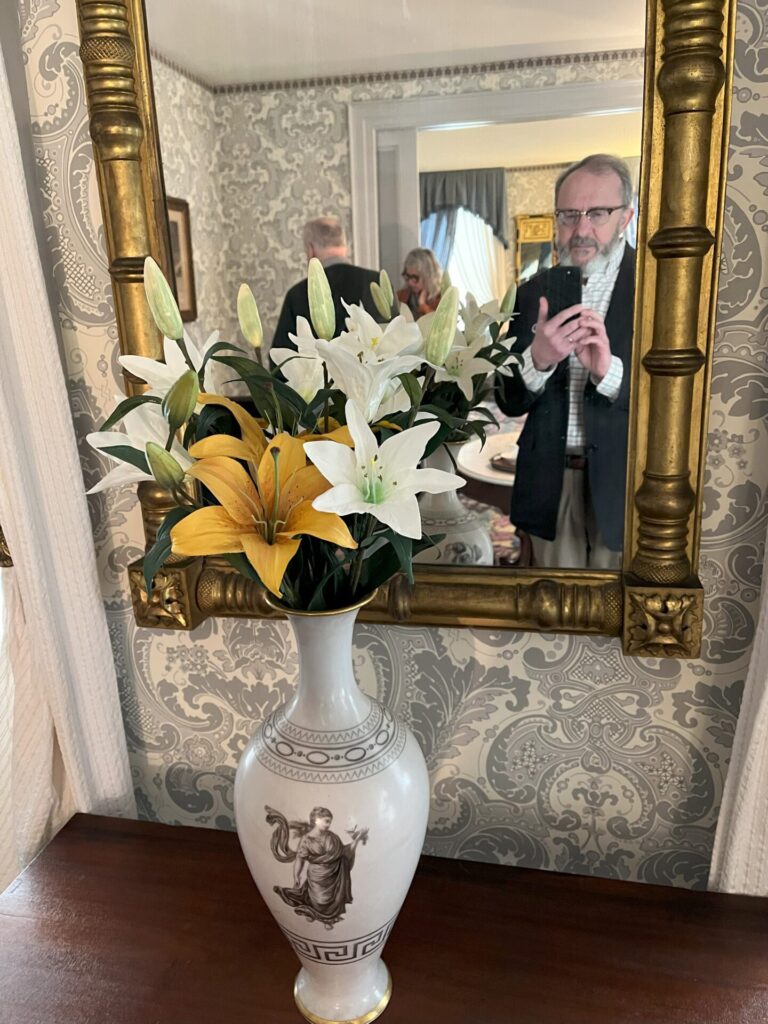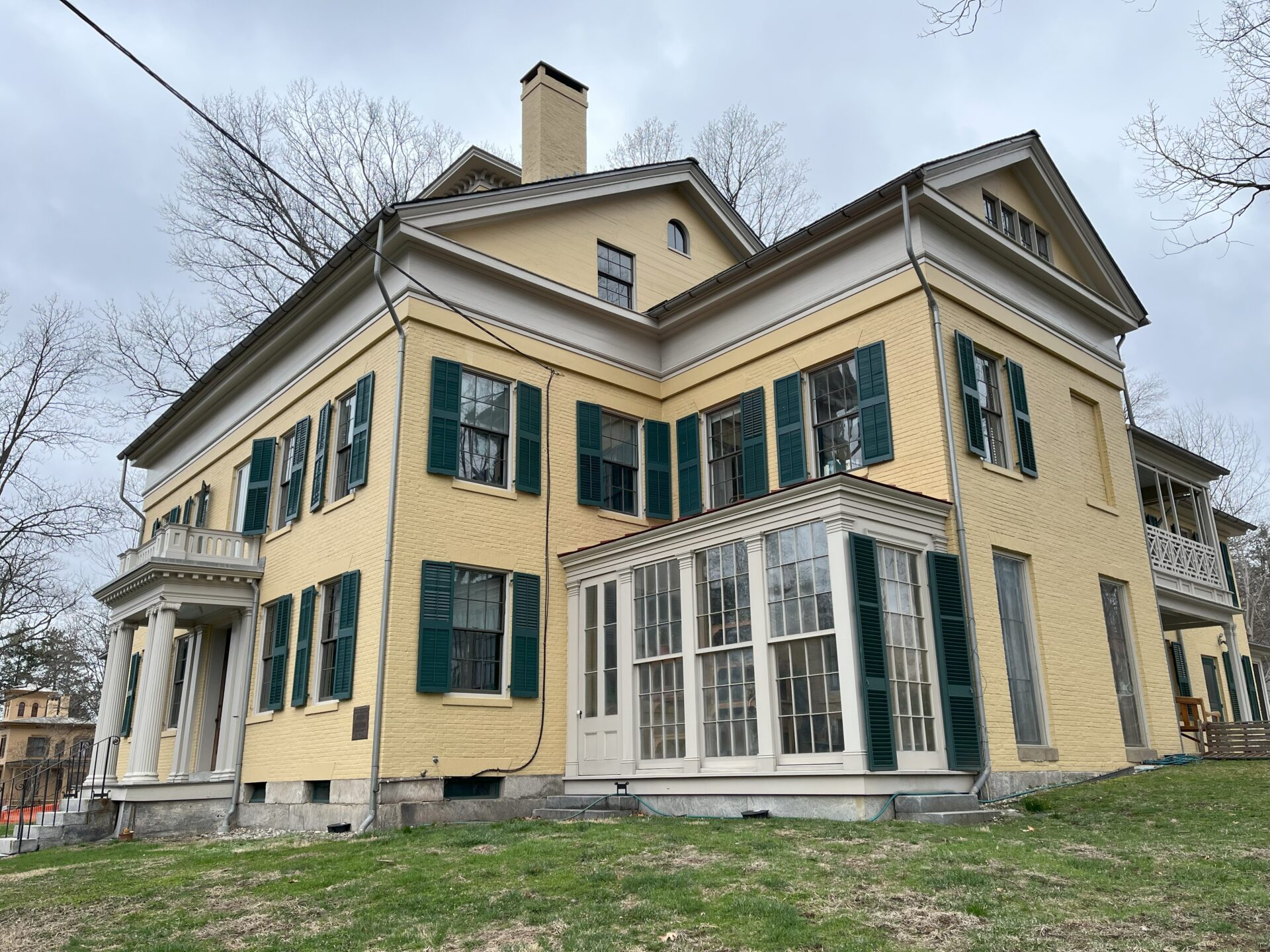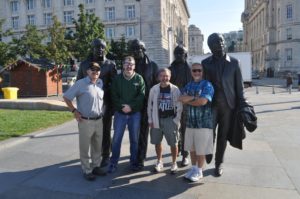Less than a mile from where I slept, studied, partied, and wrote my first journalistic words at UMass Amherst lies a well-preserved 19th century home in which one of the world’s leading poets quietly crafted poetry we still cite and study today. I never thought about visiting Emily Dickinson’s home as my life-changing experience at college unfolded in the late 1970s. I didn’t even know it was there.
I sought to correct that oversight recently when I visited my alma mater to see students who produce the college’s daily newspaper. It was a writing “roots” day for me, and I didn’t come away disappointed.

The Dickinson family home is a few hundred feet down Main Street in Amherst, Massachusetts, just off the busy North/South Pleasant Street that forms the bustling center of this famous college town. Set back from the road amid green lawns and gardens, and behind a cement/wrought-iron fence, the yellow two-story home—considered a mansion at the time—was home to a literary force who eventually sent shock waves through the world, beginning in the late-1880s. Dickinson’s over 1,800 poems were discovered by her sister, Lavinia, after Emily’s death at age 55. Prior to that no one knew of the poetry treasure trove, save for a few anonymous works published in the nearby Springfield Republican newspaper.
These days, the first floor of the quiet home contains a small entrance/lobby where an employee checks visitors in and makes sure they have pre-booked and paid for the 45-minute tour. Visitors enter through the rear of the house, facing away from Main Street. Next to the lobby is a small gift shop that you pass through before entering a conference room, where a tour guide delivers a briefing.
On the day I visited, tour guide James impressed our group of six with his knowledge of Dickinson’s poems, reciting several from memory while giving us an overview of the famous introvert’s life.
Our first stop was the family library on the first floor, facing Main Street. The Dickinsons were a well-read family. Two of the wallpapered room’s walls feature floor-to-ceiling bookcases stuffed with books. In the center of the two front-facing windows sits the large wood desk and straight-backed chair used by Emily’s father, Edward. The Yale-educated lawyer was one of Amherst’s most well-known citizens and politicians. He served in the state legislature and later was elected to Congress. Edward also served as treasurer of Amherst College. A conservative, strict parent, he encouraged his two daughters to take on the traditional roles for women of that time: housekeepers, cooks, and obedient, supportive family members. Emily and Lavinia complied. James pointed out the size of Edward’s desk and asked us to remember it when we got to Emily’s bedroom upstairs. The family’s conservatory, home to a variety of flowers and other thriving plants, can be accessed via a library door.

Our next stop was the connected parlors that take up the entire west side of the first floor. At one end are a mirror, chairs, a marble-topped circular table, and a large fireplace ensconced in a marble mantle and frame. Windows throughout the rectangular room are dressed in thick, beautiful drapes in a style common for the second half of the nineteenth century. At the other end of the parlor is the family piano and tables and chairs for sitting. Emily was a talented pianist. From the windows in the piano area, she could often see what was happening in the nearby home built for her brother, William, and his wife (and Emily’s close friend) Susan. That house, called The Evergreens, was closed for renovation when I visited, and was scheduled to reopen May 1.

After we climbed a narrow set of stairs to the second floor, James sat us down in a small conference room to give us more background on the structure of Emily’s writing.

He then brought us into what most visitors want to see: Emily’s bedroom. Lit by four windows facing west and south, her plain bed with wood headboard and end board lies against the wall at one end. Colorful, floral wallpaper adorns the walls. Opposite the bed is her writing “home.” On the left of the fireplace sits a replica of her tiny desk. The original is stored at Harvard. It’s more of a worktable than a desk. Supported by four skinny legs, it’s perhaps a fourth the size of Emily’s father’s desk downstairs. James emphasized the desk is perhaps emblematic of where Emily’s writing stood in family priority next to her father’s work. A small oil lamp sits on the left side of the desk, and a chair with a soft, black cushion is pushed back slightly. We were all surprised, but James reassured us that the petite desk is where Emily scratched out her complex prose. She wrote most often, he explained, late at night while the rest of her family slept. I was embarrassed to think of the comparatively large desk and home office in which I write today. I snapped a few photos, thinking I’d need them for proof of where Emily wrote.

An introvert for much of her life, Emily often kept track of household comings and goings from the window above the desk. There are varying opinions of just how much a homebody Emily was. Her father sent her to Mount Holyoke College (then called a seminary) in nearby South Hadley, but she only lasted a year before returning home. She was often known to talk to visitors from behind a closed door. Other reports say she sometimes interacted with people outside the house, but that was rare. Before we left the bedroom, I asked James if the white dress displayed on a mannequin was Emily’s. “No,” he replied, “it’s a replica designed to show us how she dressed at the time.”
Our last stop on the tour was a sparsely furnished bedroom adjacent to Emily’s. It was here that Emily took care of her mother, also named Emily, for seven years after she suffered a disabling stroke. She passed away in 1882, eight years after her husband died in 1874.

Emily left us four years after her mother died, unaware of the impact her writing would have on the world. She is buried in the West Cemetery in Amherst.
The 45-minute tour completed, we walked quietly down the stairs to return to the lobby and gift shop, passing the next tour group. I bought a “pocket” collection of Emily’s poetry before wandering around the grounds to take pictures of the house. I kept thinking that this small house certainly belies the magnitude of writing Emily produced in small paper notebooks known as fascicles.

***
Seeking inspiration from writers and musicians I have admired, I have visited some of their homes over the years to learn about the environment that gave birth to their creativity. Visits to Emily’s home in Amherst, Mark Twain’s house in Hartford, and John Lennon’s and Paul McCartney’s childhood homes and early performance venues in Liverpool have opened my eyes. Each of them and others have given us gifts that help expand our thinking and imagination well beyond the often-mundane experiences of everyday life.
I thought about trying to compose my own crude attempt at poetry to end this post. I gave up. Instead I delved into the book I bought in Amherst to find an Emily poem that comes close to illustrating the unscientific way I often think. Using her unusual approach to punctuation, she crafted this poem about thinking in 1863:
A Thought went up my mind today —
That I have had before —
But did not finish — some way back —
I could not fix the Year —
Nor where it went — nor why it came
The second time to me —
Nor definitely, what it was —
Have I the Art to say —
But somewhere — in my Soul — I know —
I’ve met the Thing before —
It just reminded me — ‘twas all —
And came my way no more —
***
The Emily Dickinson Museum is located at 280 Main St., Amherst, Massachusetts. You can usually park on the street in front. The museum and house are open Wednesday through Sunday, from 10 a.m. until 5 p.m. You usually need to buy a ticket and book a tour in advance. Here’s the website. The phone number is (413) 542-8161, or you can email the staff at Info@EmilyDickinsonMuseum.org




